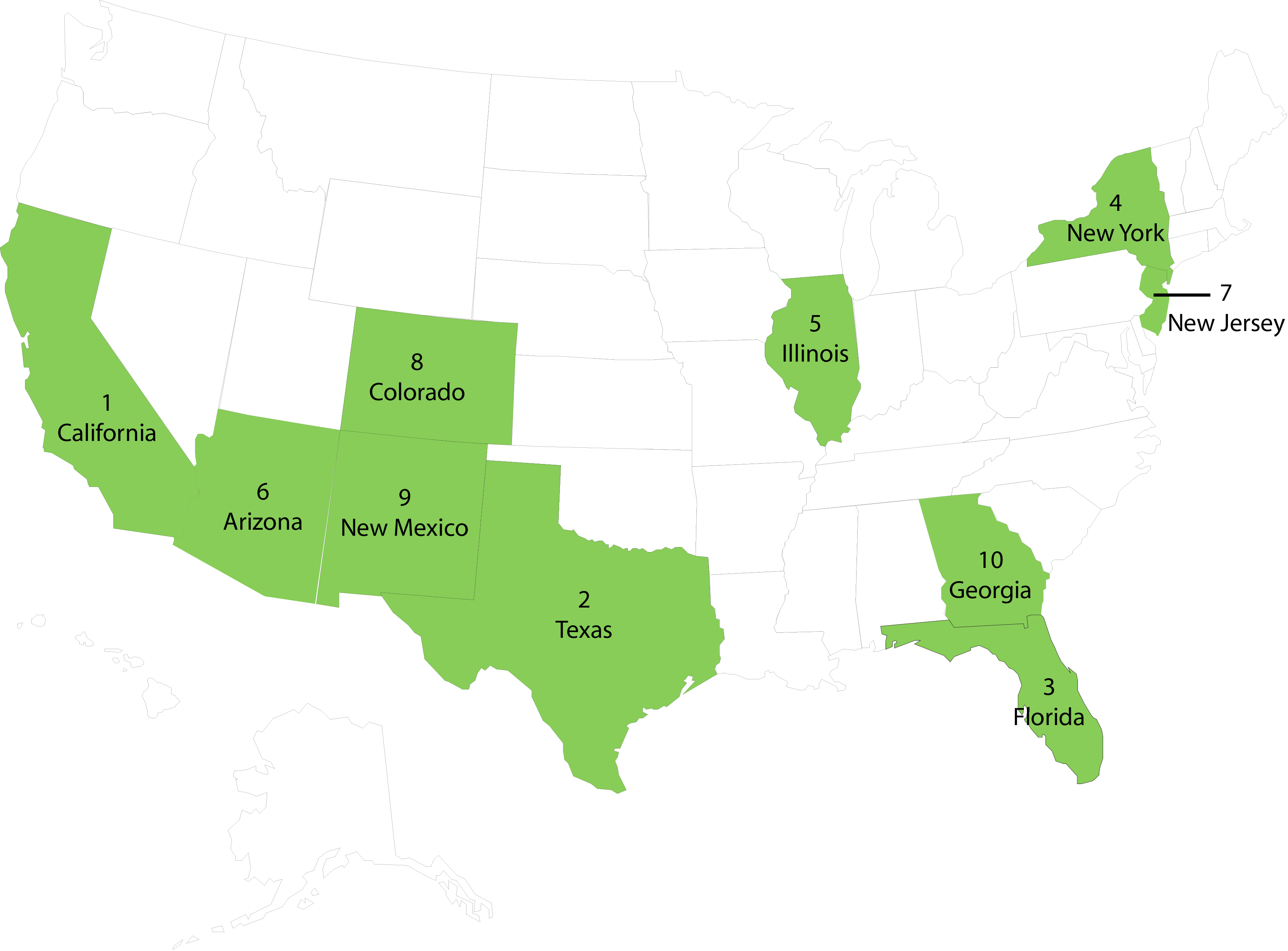Hispanic/Latino Profile

(Map of the US with the top 10 states displaying the
largest Hispanic/Latino population according to the Census Bureau)
NY - CA - IL - TX -
AZ - NJ - CO - GA - FL - NM 
Overview (Demographics): This ethnic group includes any person of Cuban, Mexican, Puerto Rican, South or Central American, or other Spanish culture or origin, regardless of race. According to the 2011 U.S. Census Bureau population estimate, there are roughly 52 million Hispanics living in the United States. This group represents 16.7 percent of the U.S. total population. In 2010, among Hispanic subgroups, Mexicans rank as the largest at 63 percent. Following Mexicans are: Central and South Americans (13.5 percent), Puerto Ricans (9.2 percent), Cubans (3.5 percent). In 2011, States with the largest Hispanic populations are California (14 million), Texas (9.8 million), New York (3.5 million), Florida (4.4 million), and Illinois (2.1 milion). Another significant point is that in 2010, 33.9 percent of Hispanics were under the age 18 in comparisons to 20.1 percent of non-Hispanic Whites. Among Hispanics, Mexicans have the largest proportion of people under age 18, at 37 percent.
Language Fluency: Language fluency varies among Hispanic subgroups who reside within the mainland United States. Census 2009 and 2010 data shows that 76 percent of Hispanics speak a language other than English at home: 76% of Mexicans, 66% of Puerto Ricans, 82% of Cubans, 92% of Salvadorans. 35 percent of Hispanics state that they are not fluent in English. Within that group, 37% of Mexicans, 54% of Central Americans, and 42% of Cubans are not yet fluent in English.
Educational Attainment: According to a 2010 U.S. Census Bureau report, 62 percent of Hispanics in comparison to 91 percent non-Hispanic Whites have a high school diploma. 13 percent of Hispanics in comparison to 31 percent of non-Hispanic whites have a bachelor's degree or higher.
Economics: According to a 2010 U.S. Census Bureau report, 26.6 percent of Hispanics, in comparison to 14.9 percent non-Hispanic Whites, work within service occupations. 19 percent of Hispanics in comparison to 40 percent of Whites work in managerial or professional occupations. Among full-time year-round workers in 2010, the average Hispanic/Latio family median income was $40,165 in comparison to $54,168 for non-Hispanic White families. In 2010, the U.S. Census bureau reported that 24.8 percent of Hispanics in comparison to 10.6 percent of non-Hispanic Whites were living at the poverty level.
Insurance Coverage: It is significant to note that Hispanics have the highest uninsured rates of any racial or ethnic group within the United States. In 2009 the Census Bureau reported that private insurance coverage among Hispanic subgroups varied as follows: 39.6 percent of Mexicans, 51.6 percent of Puerto Ricans, 51.6 percent of Cubans, 46.4 percent of other Hispanic and Latino groups. Public health coverage varied among Hispanic subgroups: 30.3 percent of Mexicans, 39.8 percent of Puerto Ricans, 31.6 of Cubans, and 26.8 percent of other Hispanic or Latino groups. Those without health insurance coverage varied among Hispanic subgroups: 33.6 percent of Mexicans, 14.9 percent of Puerto Ricans, 23 percent of Cubans and 42.4 percent of Central Americans. In 2010, 30.7 percent of the Hispanic population was not covered by health insurance, as compared to 11.7 percent of the non-Hispanic White population.
Full Census Reports:
The Hispanic Population: 2010 [PDF | 1.7MB]
We the People: Hispanics in the United States [PDF | 421KB]
The American Community Survey - Hispanics: 2004 [PDF | 1MB]
Language Use in the United States: 2007 [PDF | 1.1MB]
Census Bureau, 2011. Income, Poverty, and Health Insurance Coverage in the United States: 2010 [PDF | 2.3MB]
Health: Hispanic health is often shaped by factors such as language/cultural barriers, lack of access to preventive care, and the lack of health insurance. The Centers for Disease Control and Prevention has cited some of the leading causes of illness and death among Hispanics, which include heart disease, cancer, unintentional injuries (accidents), stroke, and diabetes. Some other health conditions and risk factors that significantly affect Hispanics are: asthma, chronic obstructive pulmonary disease, HIV/AIDS, obesity, suicide, and liver disease.
Other Health Concerns: Hispanics have higher rates of obesity than non-Hispanic Caucasians. There are also disparities among Hispanic subgroups. For instance, while the rate of low birth weight infants is lower for the total Hispanic population in comparison to non-Hispanic Caucasians, Puerto Ricans have a low birth weight rate that is 60 percent higher than the rate for non-Hispanic Caucasians. Also Puerto Ricans also suffer disproportionately from asthma, HIVAIDS and infant mortality. Mexican-Americans suffer disproportionately from diabetes.
Quick Facts
All Topics A-Z
Cancer
Diabetes
Heart Disease
HIV/AIDS
Immunization
Infant Mortality
Stroke
You will need Adobe Acrobat® Reader™ to view PDF files located on this site. If you do not already have Adobe Acrobat® Reader™, you can download here for free.





 FYI ...
FYI ... Keep Informed!
Keep Informed! Need Help?
Need Help?